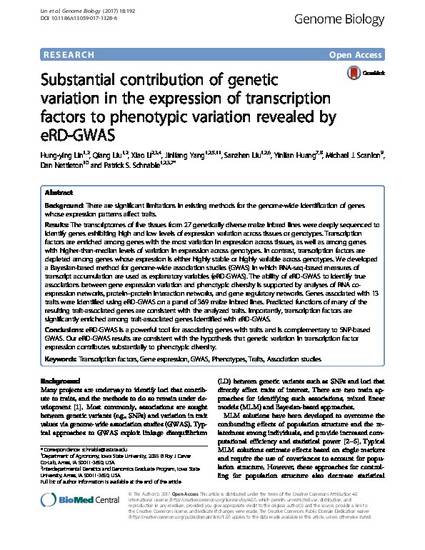
Background: There are significant limitations in existing methods for the genome-wide identification of genes whose expression patterns affect traits.
Results: The transcriptomes of five tissues from 27 genetically diverse maize inbred lines were deeply sequenced to identify genes exhibiting high and low levels of expression variation across tissues or genotypes. Transcription factors are enriched among genes with the most variation in expression across tissues, as well as among genes with higher-than-median levels of variation in expression across genotypes. In contrast, transcription factors are depleted among genes whose expression is either highly stable or highly variable across genotypes. We developed a Bayesian-based method for genome-wide association studies (GWAS) in which RNA-seq-based measures of transcript accumulation are used as explanatory variables (eRD-GWAS). The ability of eRD-GWAS to identify true associations between gene expression variation and phenotypic diversity is supported by analyses of RNA coexpression networks, protein–protein interaction networks, and gene regulatory networks. Genes associated with 13 traits were identified using eRD-GWAS on a panel of 369 maize inbred lines. Predicted functions of many of the resulting trait-associated genes are consistent with the analyzed traits. Importantly, transcription factors are significantly enriched among trait-associated genes identified with eRD-GWAS.
Conclusions: eRD-GWAS is a powerful tool for associating genes with traits and is complementary to SNP-based GWAS. Our eRD-GWAS results are consistent with the hypothesis that genetic variation in transcription factor expression contributes substantially to phenotypic diversity.
Available at: http://works.bepress.com/dan-nettleton/50/

This article is published as Lin, Hung-ying, Qiang Liu, Xiao Li, Jinliang Yang, Sanzhen Liu, Yinlian Huang, Michael J. Scanlon, Dan Nettleton, and Patrick S. Schnable. "Substantial contribution of genetic variation in the expression of transcription factors to phenotypic variation revealed by eRD-GWAS." Genome biology 18 (2017): 192. doi: 10.1186/s13059-017-1328-6.